Palani in South India is one of the most powerful temples of Lord Murugan (the second son of Lord Shiva and commander-in-chief of the deities). Legend has it that Lord Shiva and Mother Parvati were given the fruit of wisdom by Sage Narada (the sage of the deities) at their home in Mount Kailash to be given to one of their children, Lord Ganesha (the elder son of Lord Shiva) and Lord Murugan. Sage Narada suggested to give it to the one who was the first to circumambulate the universe. Lord Murugan took off on his mount, the peacock, while the wise Lord Ganesha chose to circumambulate his parents (Shiva and Shakti) and claimed that he had circled the universe as one’s parents constitute the universe. Lord Shiva accepted Lord Ganesha’s premise and gifted him the fruit of wisdom. Lord Murugan was furious at Lord Ganesha’s strategy considering it duplicitous, renounced the world, vowed never to return to his parents, and chose to reside at a hillock in South India. Lord Shiva and Mother Parvati came to the hillock and tried to placate their son who refused to return with them. They reminded Lord Murugan that he himself was the source of all knowledge and wisdom. Hence, the name of the hillock, Palani (Pazham Nee – you are the fruit)
Mohanji’s family has a pass from Palani for two people to attend the last shayan puja (ritualistically putting the Lord to sleep) in the night. This puja is special because it is unavailable to the general public and allows one closest access to the deity right inside the sanctum sanctorum. The usual view is through the door which adjoins a hall that then leads to the sanctum. Since the opportunity was available, Mohanji suggested that two people could go and participate in this pooja. Immediately I decided to go, and after a conversation with Madhu, he jumped on the opportunity too, especially since he was in Chennai that week. The fact that he spoke Tamil also made travel easier. He enquired with our local contact and we learnt that external participation in this puja had been discontinued due to COVID… Further, there was news that many Indian states were clamping down interstate access to reduce the spread of COVID which increased the risk of getting stuck in that state until the travel restrictions were eased.
Normally, I don’t care much about these issues but this time I was apprehensive especially because it was just a general darshan (holy sighting of the deity) and not the special one as Mohanji had mentioned. When I discussed my concerns with Madhu and Shaju, they both gave a “why worry when there is Mohanji” answer. Hence, throwing caution to the winds, we decided to continue as instructed. Madhu also pointed out a nice synchronicity to our planned trip to Palani, We had the blessings of visiting Kataragama on Mohanji’s birthday 2020. Kataragama was the location of Sage Boganathar’s gurukul (residential school) where Mahavatar Babaji and Mohanji studied together (as revealed by a saint from Chennai and confirmed by Devi Amma later). It was here that Sage Boganathar taught Mahavatar Babaji the science of kriya yoga. There is a strong Mahavatar Babaji connection to Palani as will be revealed later. Hence, the Babaji (and Siddha tradition) connection to this year’s trip on Mohanji’s birthday was too obvious to ignore. Palani is the location of Sage Boganathar’s jeeva (live) samadhi (his final resting place).
Sage Boganathar is considered to be the second most important Siddha Master after Sage Agastya who is considered the head of the Siddha Tradition. The Siddha Tradition (siddha means perfected one) finds its roots in ancient South India and is considered to be as ancient as the creation of the four Yugas (ages). Sage Agastya was one of the Sapta Rishis – the seven illustrious sages who were handed over Supreme Knowledge by Lord Shiva Himself to spread through the Universe. Sage Agastya is considered equivalent to the Prajapatis – the creators who were mind born sons of Lord Brahma, the Supreme Creator – who carried on the task of creation through the multitude of universes. Like Mohanji, Boganathar was also a well-heeled traveler (in the days without passports, visas and immigration control) who had traveled the world especially the Far East and the Middle East having visited Tibet, China, Mecca, Medina etc. It is said that he was known in the Far East as Lao Tzu and his disciple Bodhidharma took the ancient art of kalari (traditional Indian martial arts) and founded the Shaolin temple.
Palani is also considered the home of siddha medicine (an extensive medical science and practice that combines divinity and herbs) which is said to have come from Lord Murugan himself through Sage Agastya and his disciples such as Sage Boganathar. In consultation with the eighteen foremost Siddhas among the Siddha Tradition, Sage Boganathar created an idol of Lord Murugan using the nava pashaana (the nine deadly poisons made from 4000 rare herbs). He is said to have used Mahavatar Babaji as the likeness to create the idol since Mahavatar Babaji was an incarnation of Lord Murugan Himself. This is the Mahavatar Babaji connection to Palani mentioned earlier. This unique idol has the property that water or liquids that are poured on it have powerful rejuvenative powers and are believed to cure all human diseases. In other words, the nine poisons in combination work to impart the most therapeutic and life giving essences to the liquids poured on it. It is said that Sage Boganathar made nine such idols that will be revealed in due time. Sage Boganathar lived for more than three hundred years and is believed to have made his own samadhi here. With this history, imagine the good fortune of getting the blessings of merely visiting such a place. In our case, we were given the blessings to be there by our Guru (Mohanji) Himself. Seems very silly now in retrospect to have had any apprehensions at all. A reminder to just follow the Guru’s instructions without question rather than use the mind (the source of much folly) and mess up the divine order (pun intended).
We arrived in Coimbatore separately (Madhu from Chennai, me from Bangalore) at 7 a.m. and took a taxi from the airport to Palani. The two closest airports to Palani are Coimbatore and Madurai. We didn’t have a specific plan and chose to play it by the ear. We booked a room at the temple accommodation, dropped off our baggage, took a quick shower and headed out. We had been asked by our local contact to reach the temple by 10:30 a.m. and check the ground scenario. We decided to first have a morning darshan and then purchase a pass for the privilege to pull the Lord’s chariot when He is taken around the temple in the evening to see all his devotees who are waiting in earnest to see the Lord up close and personal. We planned to attend the last puja after the chariot pulling. This allowed enough time to allow divine intervention to sprout some connections for us to attend the elusive, exclusive late night puja.
The temple complex is atop a small hill and it took us 30min to climb the 500 odd steps as we paid our obeisance at the several small temples of Lord Ganesha in His different aspects. The many shrines of Lord Ganesha denote the affectionate elder brother running around his younger sibling Lord Murugan to take him back to their abode at Mount Kailash. Many of the shrines have Lord Murugan sitting on Lord Ganesha’s lap symbolizing their eternal love for each other. There is another disciple of Sage Agastya called Pulippani who is said to ride on a tiger. His ashram and shrine are on top of a hillock and the steps leading to his shrine are close to the entrance of the walkway to the main shrine.
There are also temples of various siddha Masters including Sage Edumbar the protector of the hills. It is said that Sage Edumbar carries the two hillocks of Palani on either ends of a huge rod. There is a background story with Sage Edumbar and Lord Murugan. After Sage Agastya left, the powerful Sage Edumbar encountered the young Lord Murugan and tried to forcefully remove him. With a short kick, the young Lord fatally disposed off the powerful Sage. Sage Agastya entreated the young Lord on his disciple’s behalf and thus pleased, the young Lord revived Sage Edumbar. He further ordained that while he would reside at the top of the hillock, Sage Edumbar would have his place in the middle and the first puja (ritual worship) would be given to Sage Edumbar.
As we walked to the top, shouts of “Murugan arohara” could be heard from the pilgrims climbing the mountain (arohara is a shortened form of “ara haro hara” – Oh Murugan, Lord Almighty, please remove our sufferings and grant us salvation). We encountered several dogs, monkeys and beggars and realized that we had, in our haste, forgotten rule number one of Mohanji travel – carrying biscuits and bananas to serve our two and four-legged friends. Since there were no shops on the hill, nothing could be done so we pressed on with the climb. When we reached the top, we headed to the main temple of Lord Murugan. The normal view was from a barricade that was set up further ten to fifteen feet away from the door that opened into the hall that led to the sanctum. Further, the devotees could only be there for a few seconds before the security pushed them away to make way for the ones behind.
A person opened the barricade and took us right up to the door that allowed us the most amazing darshan of Lord Murugan in his child form. Lord Murugan like Mahavatar Babaji is depicted as a young boy and maintains that form always. There are seven different forms that Lord Murugan is adorned for each of the intervals in the day (cosmic form, hermit, hunter, child, king, saint and so on). The person also did a private puja for us at the shrine and allowed us ample time to stay there and view the Lord in peace, away from the hustle and bustle, and pushing and shoving. Fully satisfied, we left for the Boganathar samadhi. The samadhi temple is beautiful with large life-size paintings of Sage Boganathar and Mother Bhuvaneshwari (who Sage Boganathar meditated upon) at the entrance of the temple on either side. Atop the entrance is a life-size statue of Sage Boganathar sitting deep in meditation. The energy was amazing and one can feel the great Master’s presence all around, even outside the temple.
We entered the temple and walked around the circular path leading to the samadhi that is situated on the other side of the entrance. The wall along the path on either side is painted with murals that tell the stories of Sage Boganathar, Lord Murugan and the Palani temple. A few times, we tried to sit on the walkway and meditate but were flushed out by the priests. Madhu being the inquisitive one tried to ask the presiding priest about the various aspects of the samadhi mentioned on the walls. Since the priest was busy attending to the devotees, he excused himself from Madhu’s rapid-fire round. We paid our respects at the samadhi and headed out. We sat outside the temple but were soon flushed out from there since they were cleaning the place and were performing the noon puja (ritual) which was done by the priests and is not available to the public.
As planned earlier, we went to purchase our pass and passed our time at the office reception area, attending to pending email/messages and tasks. After a while, Madhu suggested that we head back to the temple complex since he wanted to do kriya at the Sage Boganathar’s samadhi. We returned to the Sage Boganathar’s samadhi temple and chose our respective spots to meditate. I could feel the presence of Sage Boganathar and had the intuition that Mahavatar Babaji (the likeness for the idol of Lord Murugan) in the main Murugan shrine worshipped his Guru Sage Boganathar who in turn worshipped Lord Murugan. Kind of like a mutual admiration society. A little while later, I ceased my meditation and looked around for Madhu. I found him seated with the presiding priest of the Sage Boganathar samadhi just outside the temple towards the right and approached them.
Madhu told me that when the priest saw Madhu outside the temple he asked Madhu to sit with him and get clarifications to Madhu’s earlier queries that he was unable to address inside the temple, due to the milling crowds. Since he spoke only Tamil, Madhu did most of the talking (and translating). The priest told us that most people come to the main Lord Murugan shrine, just pass through the Sage Boganathar samadhi and go away. He heard the priests driving us out several times during our futile attempts to sit in the samadhi temple. He also noticed that we went inside a couple of times for extra darshan and Madhu had asked him to explain the structure of the samadhi since flowers were blocking the view. Hence, he felt that we were serious seekers and keen to learn. Hence, he called out to Madhu when we came back to the temple.
The priest informed us that this was Boganathar’s jeeva (live) samadhi and Boganathar was, in fact, meditating under the structure in nirvikalpa samadhi (one with the supreme consciousness), delivering blessings and benedictions to the world. Some people were performing abhishekams to the temple wall next to us with rose water. When I looked at the priest quizzically, he dismissed it with disdain, probably hinting it as a charlatan way of some of the temple priests to make money off gullible devotees. We spoke to him about Mohanji and gave him Mohanji’s picture card. He stared at it for a long time and spoke about Mohanji with a lot of familiarity. We informed him that it was Mohanji’s birthday and asked him to pray for Mohanji on this auspicious occasion. He affirmed that he would do the needful.
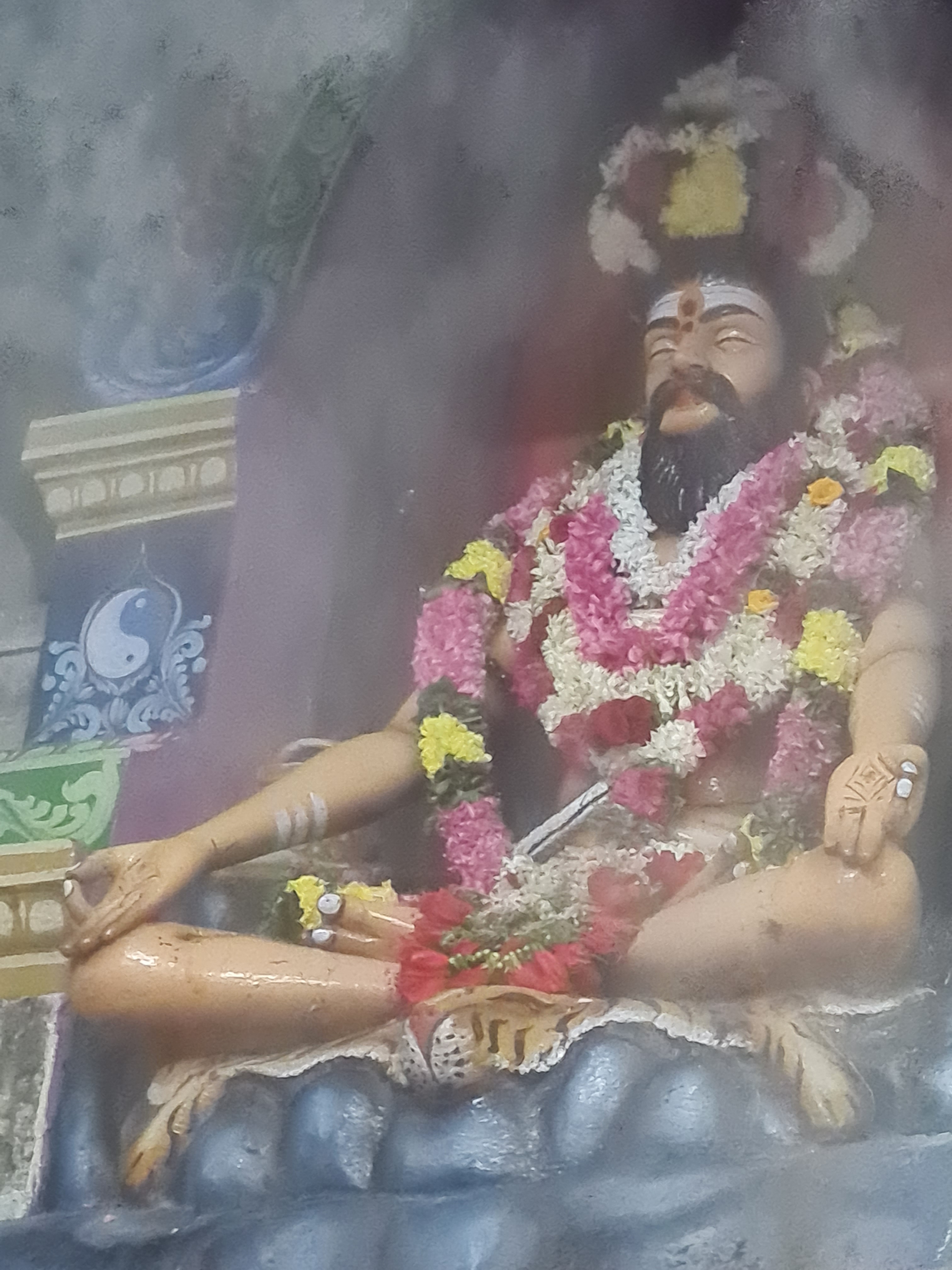
Out of the blue, a question popped in my mind at that moment, “Does this place have a secret location and a secret sadhana?” It surely wasn’t something that arose from a logical enquiry. I asked Madhu to check with the priest. The priest was silent for a while, then got up and asked us to follow. A few metres away there was a small alcove where some priests were hanging around earlier. It was a nondescript place that was small and empty except for a few wooden box-like structures and had a couple of cast iron doors, one facing the entrance and the other to the right. The left side of the place was the wall of the Sage Boganathar samadhi temple. Earlier, the priests were sitting on the box-like structures and working with some of the devotees there. It looked ordinary and there was nothing to attribute any special importance to that place.
The priest told us that the door to the right led to Mother Bhuvaneshwari and the door in front led to Lord Shiva. In ancient times, Sage Boganathar would be seated at the center of this place and would meditate upon both deities. He told us, “Your Guru loves you deeply and unconditionally. Hence, he sent you here to allow you to experience this unique place (not just Palani but the place where he had taken us). The two Gurus (Mohanji and Sage Boganathar) have worked together to deliver you this experience and they have used me as a conduit to present it.” The priest made us sit there, took out a small red silky pouch from his waist which had a plastic ziploc bag with wet sandalwood paste that was applied on the Murugan idol (the statue made of the nine poisons) in the main shrine. This sandalwood is called rakkal chandanam and is given as a rare prasadam (consecrated offering) in the morning for devotees to eat.
A story about Lord Murugan and Sage Agastya reveals the significance of the sandalwood applied on the Lord. When Lord Murugan reached the hillock at Palani, he was roaming around and playing with the animals there such as snakes, peacocks, and so on. His activities disturbed Sage Agastya who was residing on the hill with his disciples that included Sage Edumbar. In his impatience, the sage failed to recognize the young Lord. The sage requested the young Lord to stop the disturbance and go elsewhere. The young Lord retorted, “Old man, if you are getting disturbed, it is you who should leave.” The sage was enraged by the gall of the child to speak to him so disrespectfully. He chanted mantras to finish off the child.
But the child remained unmoved and unaffected, continuing to play and laugh at the sage. This puzzled the sage since no mere mortal or sage could have withstood the deadly incantation. The child gave the sage a piece of dried sandalwood paste from his forehead and asked the sage to taste it. Though skeptical, Sage Agastya put the piece in his mouth and was immediately thrown off balance into space with no knowledge of where he was or how to get back. He immediately realized that the child was none other than the son of his Master, Lord Shiva. He apologized, was brought back to the hillock at Palani and became a disciple of Lord Murugan.

I suddenly remembered that an old man had come to us during our visit to the main shrine and given both of us a sizable ball of sandalwood paste. When I tried to apply it to my forehead, he shook his head and asked me to consume it. Sheer grace from Mohanji to receive this powerful offering and doubly so now from this priest at the Sage Boganathar samadhi. The priest took out a very small quantity the size of a peppercorn and gave it to each of us. He said it was very powerful and a great aid to meditation. The usual quantity dispensed was the size of a mustard seed but since we were meditating there, he gave us a larger quantity. He asked us to place the sandalwood under the tongue and meditate there. He said he would return later, to continue our discussions.
I couldn’t meditate for a long time as my mind was furiously trying to make sense of all that was happening. I opened my eyes and saw the priest sitting in front of me with his back towards me. Madhu was to my right doing his kriya practice. I closed my eyes again trying to meditate. My mind was not agitated but neither was it in a mood to be silent or go within. Later when I checked with Madhu, he had the same experience that he couldn’t concentrate and his mind was in overdrive. After a while, Madhu came around and then our conversation with the priest continued. He enquired about our immediate families. Madhu informed him of his parents, wife and kids. Madhu mentioned that I was a bachelor. His eyes lit up and he said, “Excellent.” He mentioned that he was a bachelor as well and had dedicated his life to Sage Boganathar and the Siddha Tradition. He said that bachelorhood was a great blessing from one’s Master to allow one to lead a life without the pull of terrestrial obligations. He elaborated on the power of the wet sandalwood paste (that he had given us) and suggested a sadhana related to the same. I asked him if he had seen Boganathar. He responded with a cryptic “He is in me.”
He then asked us to go back to our temple room, rest for some time and return to the Sage Boganathar samadhi temple at 6 p.m. It was around 2 p.m. He told us to take the afternoon lunch prasadam from the temple. He took us to the place where they were giving the lunch prasadam, went inside and brought three packets of food. The food was packed in a banana leaf that was neatly packed in a newspaper and was piping hot. He then told us to meet him back at 6 p.m. and took our leave. We wondered why he had given us three packets when it was just the two of us. We decided to offer it to one of the pilgrims in the temple complex.

As if on cue, a middle aged person came to us and asked us for the location where he could collect the lunch prasadam. We pointed him to the location and also offered him the extra packet which he gladly accepted. The divine grace of Mohanji to allow us to perform annadaan (food donation) before consuming our food. The lunch prasadam was a simple but tasty lemon rice with some pickle. We polished it off in no time and started our journey to the bottom. There is a cable car system as well that allows people to go back and forth and avoid the steps completely. However, we chose to walk down the steps and soon reached the bottom. Before we returned to our temple accommodation, we went to the bus station and checked on the bus timings to plan our onward journey (me to Palakkad, Madhu to Madurai and then to Chennai).
On our way from the temple accommodation to the entrance of the steps leading to the shrine, I noticed a place where they were tonsuring people who offered their hair as an offering to the Lord. Madhu mentioned that this is supposedly a standard practice in many temples in the South. There were many shining pates around which meant that many used the service. Some of the pates were anointed with sandalwood to cool them down. Before I met Mohanji, I had visited an ashram deep in the Himalayas a couple of times where the Master (when in the flesh) would require his followers and visitors to shave their heads before entering the ashram. Anyone who refused was denied entry. It was a symbolic offering of the ego before one enters.
Since then, I had done this on several occasions when I felt an inner calling. I felt the same in Palani as well but was unsure. The bald pates floating around me were egging me to go for it. I finally prayed internally to lead me if it was necessary for this trip. Before we entered our room, we stopped outside the temple accommodation to get some tender coconut water. When I looked up, I saw an image advertising the tonsure service. I took it as a cue for me to go forth and lose the hair. The barber did not take much time to give me a shining face and head. Through the process, I visualized surrendering to Mohanji all the resistance and ego within me and requested him to accept my symbolic surrender. I headed from there to our room. A quick shower and a short rest later, we were headed back to the temple complex.
We stopped by for a coffee when an old lady came by asking for money. We offered her food instead which she gladly accepted. She had coffee and a takeout meal and blessed us profusely. She was a gentle nudge from Mohanji to take biscuits and bananas with us before climbing the steps. We did the needful and distributed them all along the way to the top to all the dogs, monkeys, beggars as well as the street vendors. As we reached the temple complex, we headed straight to the Sage Boganathar samadhi temple. We waited outside the temple entrance and were joined soon by the presiding priest. He asked us to join him inside and take another darshan since he wanted to explain the different aspects of the samadhi. We of course relished the idea of going in there again and knowing more.
The stone altar at the bottom houses Sage Boganathar’s samadhi. Above the altar is a three dimensional Sri Chakram (a geometric representation of the primoridal Divine Mother) also known as Mahameru. Above the Sri Chakra is a throne that was created by Sage Boganathar himself that is crowned by the Maragatha (emerald) Shiva Lingam (a representation of the Supreme Unmanifested Consciousness or Divine Masculine). To the left of the Shiva Lingam are Lord Dandapani (Lord Murugan in his ascetic form holding a staff) and Lord Subramanya (Lord Murugan in his beatific form). Above the Lingam is Mother Bhuvaneshwari, the primordial source of all Creation. In addition to the exalted energy of the great Sage, the priest mentioned that the samadhi is extremely powerful due to the presence of all these powerful deities. Except for the stone altar and the deities on either side of the Lingam, most of the altar is covered with heaping flowers. He lifted the flowers a bit to allow us to see the underlying idols. It is said that under the temple, there is a secret cave route between Boganathar’s samadhi and Lord Murugan’s shrine.
The priest did a special ritual for us at the samadhi. He gave us flowers from the altar, kumkum (a sacred red dyed powder used for the Divine Mother), vibhuti (sacred ash) and other consecrated offerings. He also returned the picture card of Mohanji that we had given him for blessing at Sage Boganathar’s samadhi. He had done an abhishekam (ritual bathing) on the picture card with vibhuti (sacred ash), kept it on the samadhi and prayed for Mohanji. When done, we went back to our special place, meditated there for some time, took his leave and headed for the chariot procession ceremony that was due soon.
We took the opportunity to circumambulate the temple. Soon the golden chariot with the idol of Lord Murugan was brought out to allow him to see all his devotees around the temple complex and vice versa. The golden chariot is very ornate and bedecked with lights and has flags at the six corners of the hexagonal altar. The idol of the Lord is decorated with flowers, ornaments and decorative and embroidered clothes. It is truly a wonderful and beautiful sight. People await their turns to pull the chariot at each of the marked places around the temple complex. The system is well orchestrated and the people were well behaved without any pushing or shoving. When it was our turn, I found it hard to believe that we were pulling the chariot of Lord Muruga in Palani – a truly rare and amazing opportunity. All thanks to the grace of Mohanji who had orchestrated this trip so beautifully. With each step of the chariot pulling, I expressed my deepest heartfelt gratitude.
We decided to head back to the sage Boganathar temple one last time since Madhu wanted to do one last round of kriya there. As he sat down for kriya, I just sat facing the entrance of the samadhi temple. Soon all the priests gathered outside the temple and one of them climbed on top of the temple entrance to worship the Sage Boganathar statue there. He bathed it with rose water and cleaned the statue and wiped it. He then anointed Sage Boganathar’s with sandalwood, turmeric and kumkum. He then bedecked the statue with garlands and also placed several flowers around his matted hair. Sage Boganathar looked beautiful and alive, sitting deep in meditation showering blessings on the the devotees admiring his resplendent form. Finally, they waved incense sticks and lamps to complete the ritual.

From there, we moved back to the main shrine. Towards the exit from the Sage Boganathar samadhi temple, there is a open temple which has shrines of the eighteen Siddhas. Sage Agastya, Sage Boganathar, Sage Gorakhnath and Sage Macchindranath (the foremost Masters of the Nath Tradition), Sage Patanjali (who devised the ancient system of traditional yoga), Sage Dhanvantari (who evolved the ancient systems of medicine), Valmiki (the composer of the epic, the Ramayana) and so on. Madhu prayed deeply to Patanjali for the success of the Himalayan School of Traditional Yoga. I found an incense stick at a Shiva temple outside the main shrine. Using the incense stick, we did an aarati to Mohanji for his birthday, outside the main shrine. It was a fitting finale to close our pilgrimage.

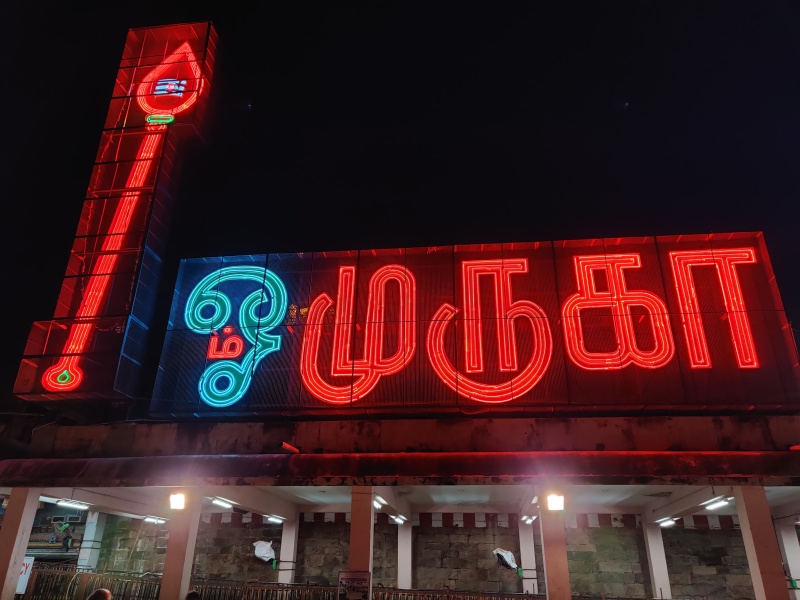

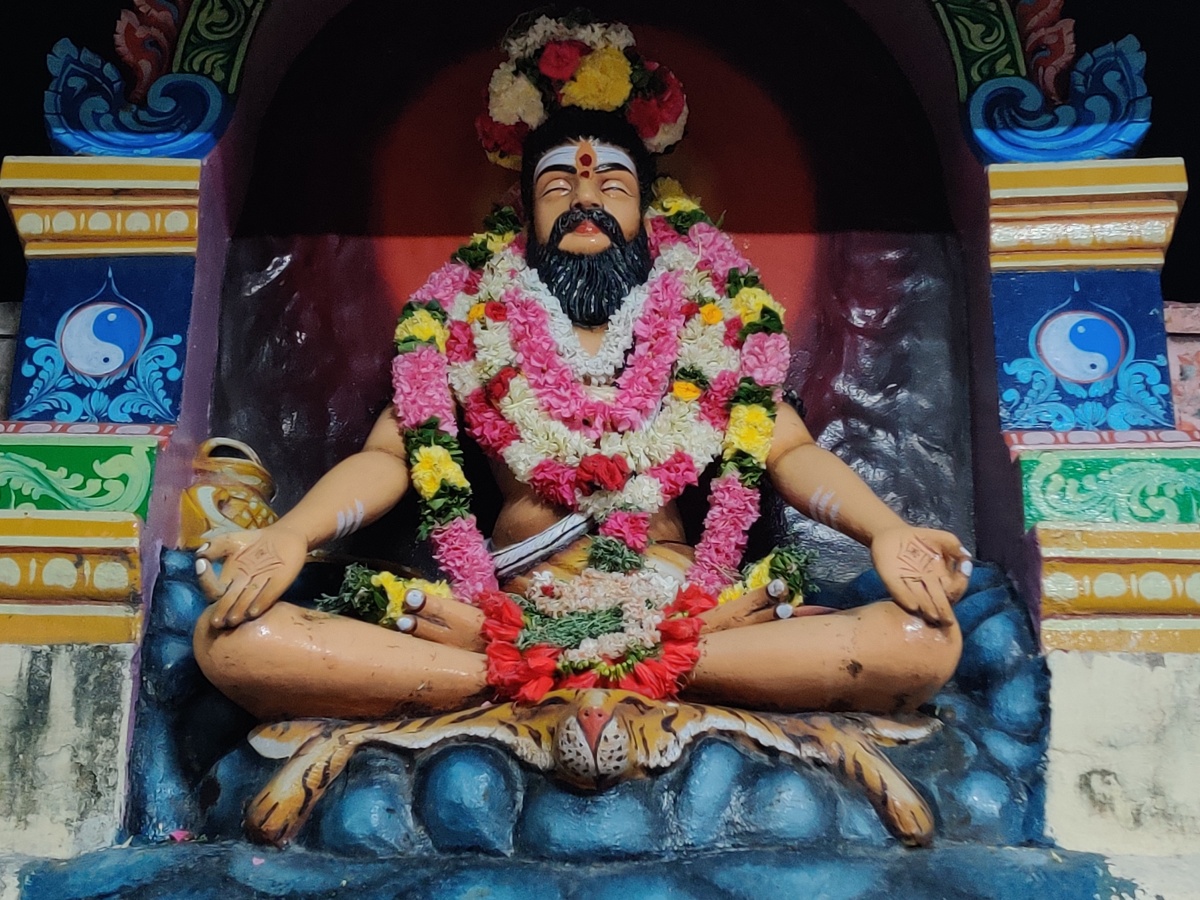
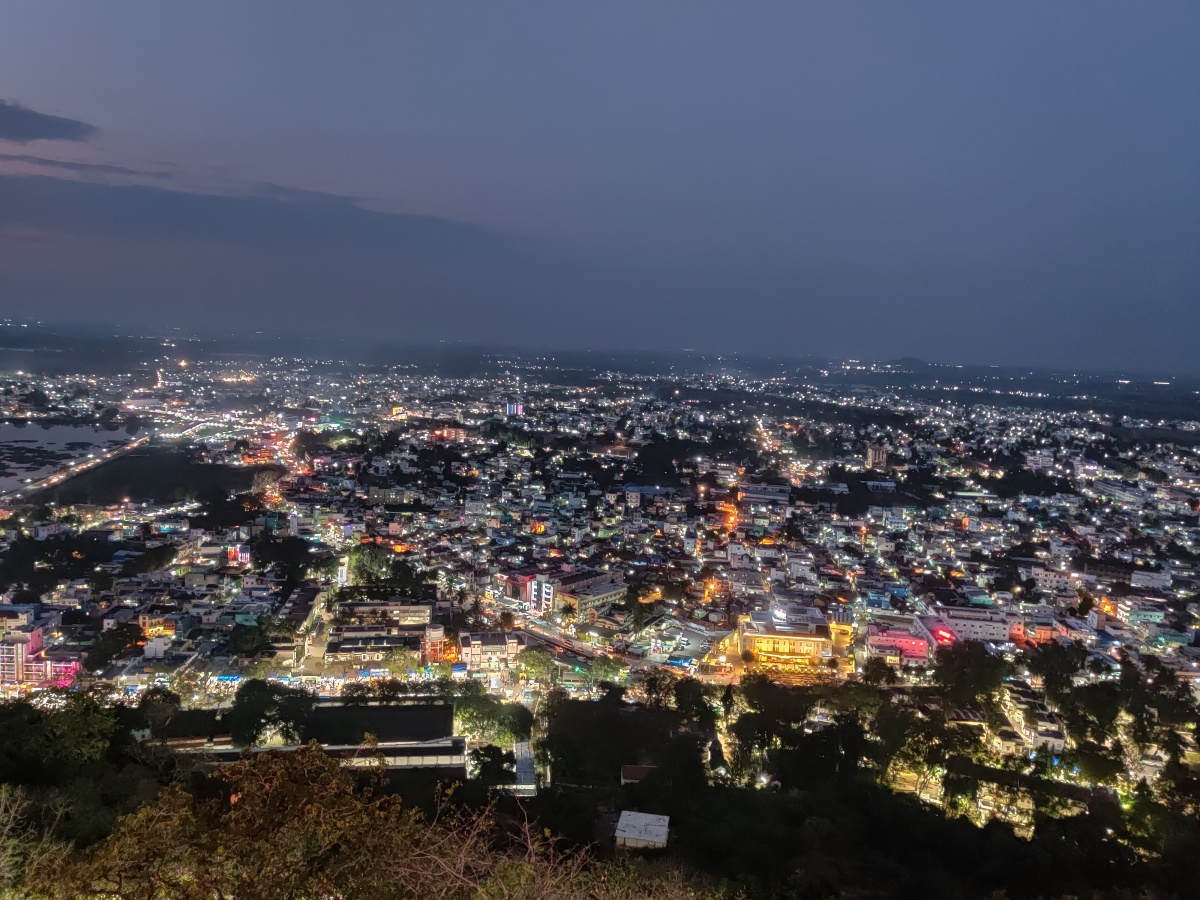
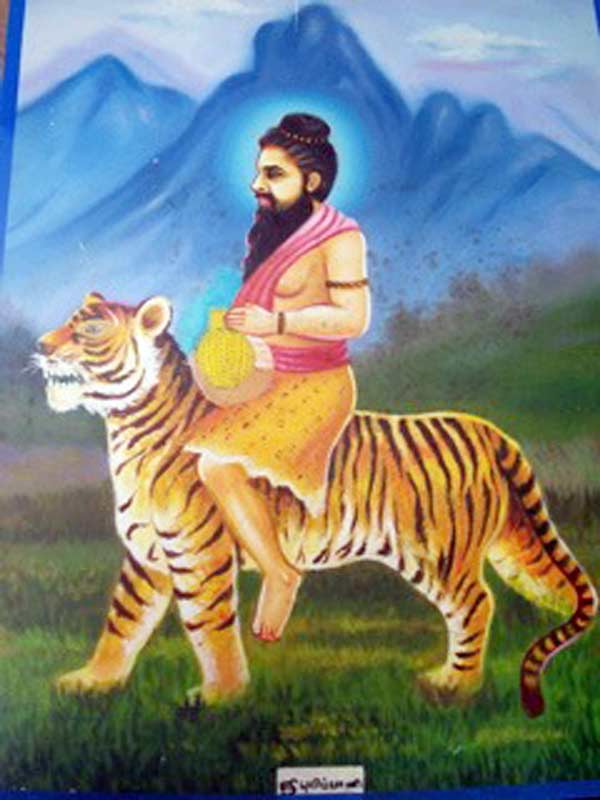
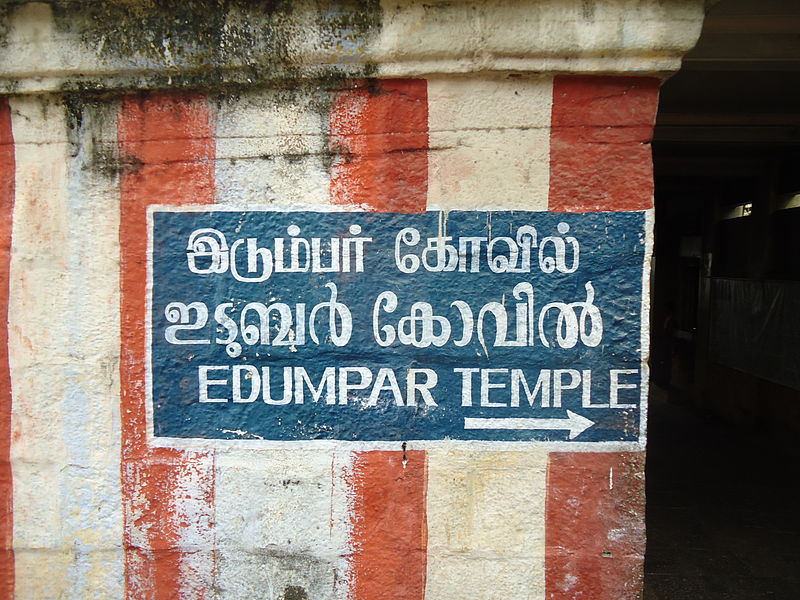




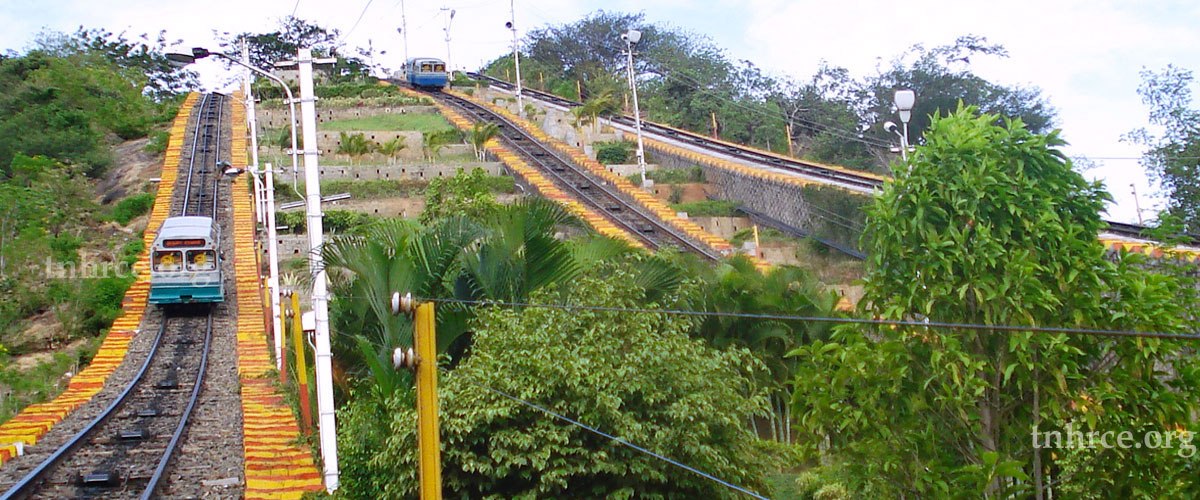
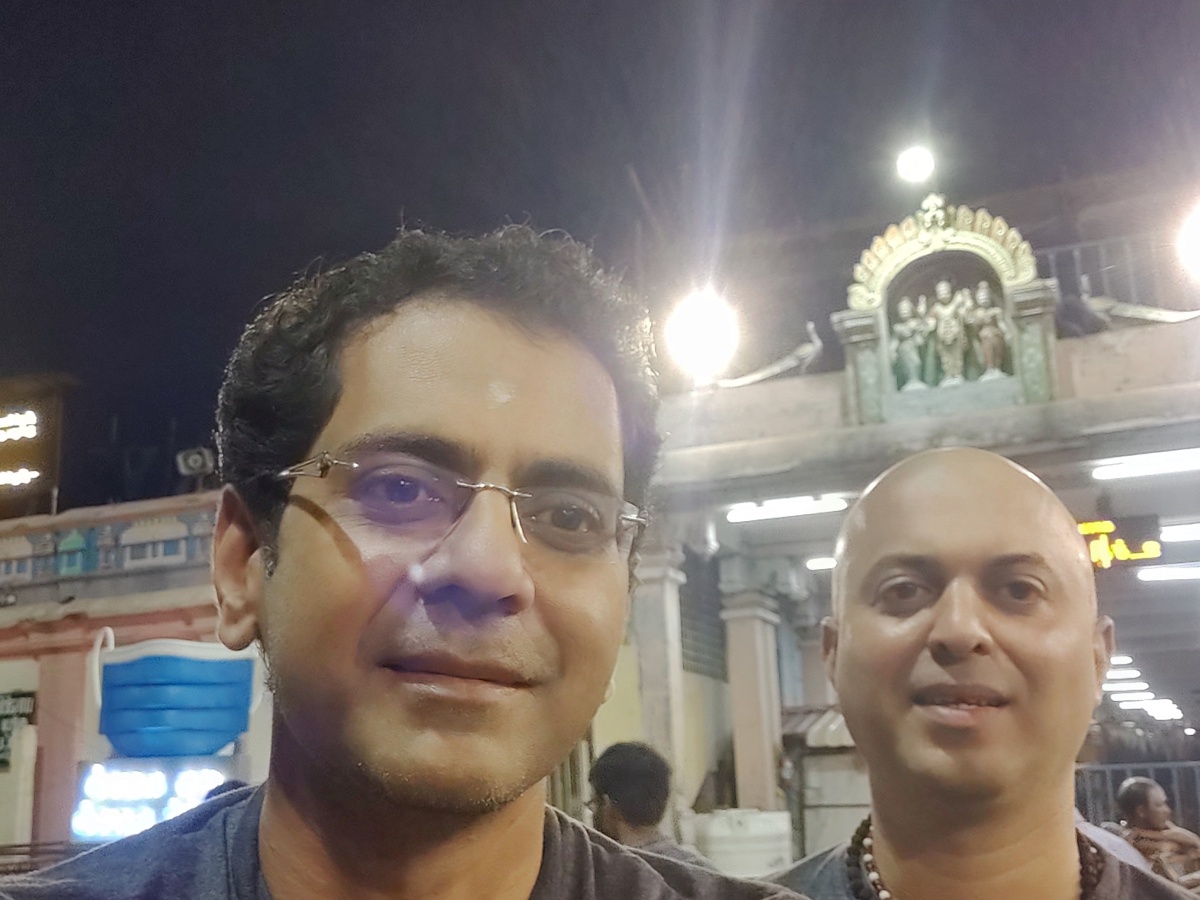


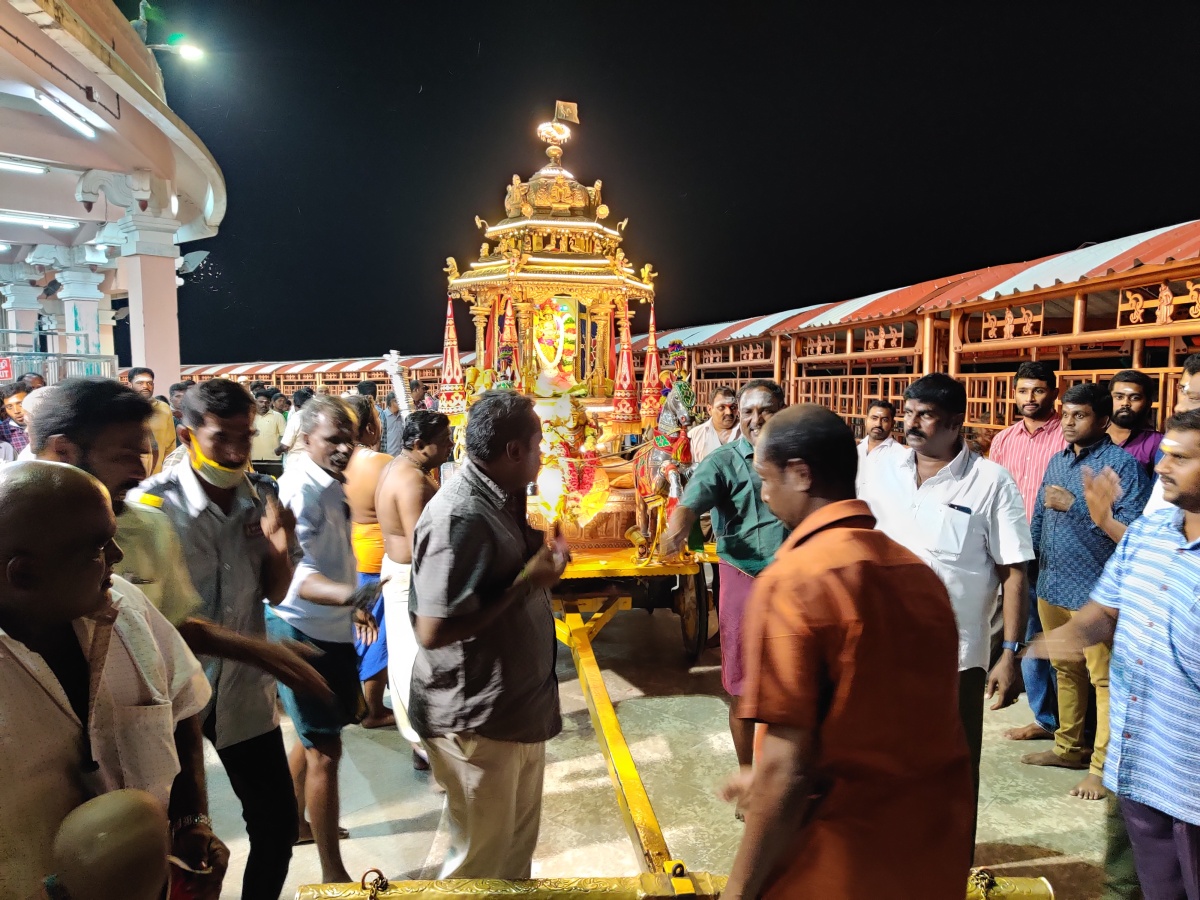
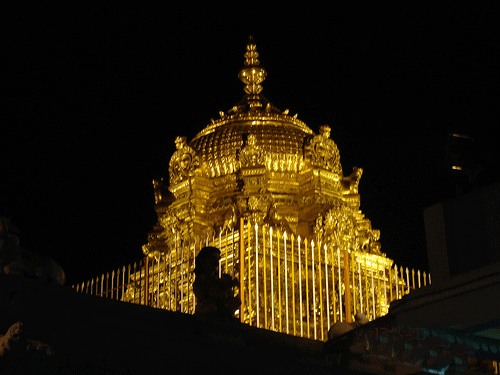
1 thought on “Pilgrimage to Palani on Mohanji’s Birthday”
it was indeed a great privilege to read this and learn many things which was not known till date.